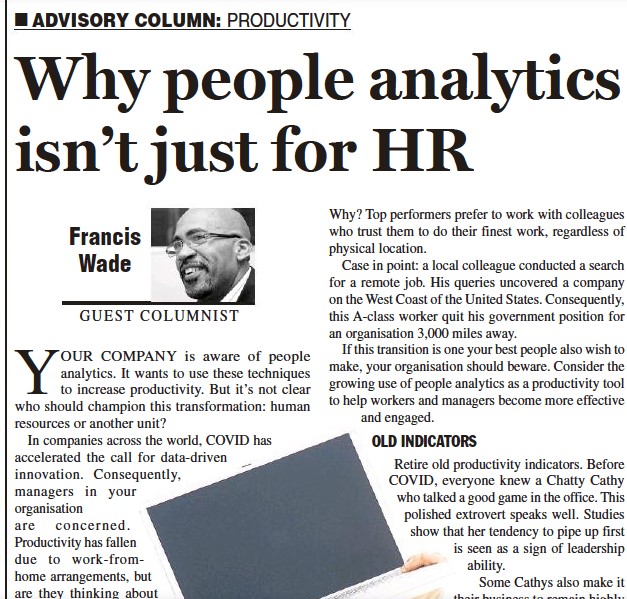Your company is aware of people analytics. It wants to use these techniques to increase productivity. But it’s not clear who should champion this transformation: HR or another unit?
In companies across the world, COVID has accelerated the call for data-driven innovation. Consequently, managers in your organization are concerned. Productivity has fallen due to work-from-home arrangements, but are they thinking about improving it in the best way?
The traditional approach to determine knowledge-worker productivity is borrowed from the factory floor. Put people together in tight quarters. Keep a close eye on them. Then, make sure their bodies are doing the right things.
However, COVID has blown a hole in that practice. Now, it’s obvious that, unlike physical work, knowledge work can be performed anywhere. But this fact hasn’t stopped your managers from campaigning for a return to “the good old days”.
Fortunately, stale, inefficient ways of full-time face-to-face working aren’t coming back. Also, companies which insist on treating employees as if they are manual workers will see their best people leave. Why? Top performers prefer to work with colleagues who trust them to do their finest work, regardless of physical location.
Case in point: a local colleague conducted a search for a remote job. His queries uncovered a company on the US West Coast. Consequently, this A-class worker quit his government position for an organization 3000 miles away.
If this transition is one your best people also wish to make, your organization should beware. Consider the growing use of People Analytics as a productivity tool to help workers and managers become more effective and engaged. Here are three steps.
- Retire Old Productivity Indicators
Before COVID, everyone knew a Chatty Cathy who talked a good game in the office. This polished extrovert speaks well. Studies show that her tendency to pipe up first is seen as a sign of leadership ability.
Some Cathys also make it their business to remain highly visible. They attend all meetings involving executive exposure. They never stay quiet, so their voices are known.
Finally, Cathys always arrive to work early and leave late. And on weekends, email threads never lack their input.
In summary, Cathys play into the weakness of managers who judge productivity visually. This lazy method of assessment promotes Cathys, even if their actual work is only average.
Unfortunately for them, COVID has changed the game. Gone are the visual cues Chatty Cathy used to wow managers. And the old flawed ways of measuring her productivity may never return.
- New Productivity Challenges Being Ignored
If you have never heard of “People Analytics” you may not realize that it’s an update to the notion of “HR Analytics”.
They are used everywhere employees can be found…not just in HR. For example, metrics are being gathered to reverse productivity losses in two nagging areas: email and meetings.
Both problems have become worse due to COVID according to research by Harvard Business School. In spite of the negative impact, companies treat them like rush-hour traffic – something we all hate but can do nothing about.
Today, rudimentary analytics tools are measuring both.
For example, your company could end each meeting with a smartphone survey of attendees. This should improve its quality.
Email effectiveness can also be surveyed manually, but that’s not all. Sites like emailanalytics.com measure an individual’s message volume and responsiveness automatically.
For instance, it helps you see that a manager who has 3,456 unread email messages is not just “bad at email”. He is a nuisance to his colleagues and an unproductive detriment to the bottom line.
I mention these two areas because they are relatively easy to measure. All it takes is a serious commitment to productivity. Plus a willingness for managers to use data to identify their lack of efficiency.
- HR’s Capacity to Lead People Analytics
Your HR Department may not be thinking in this way yet. It may not even have tools or skills available. The truth is that few are ready to lead their companies in this area.
Instead, HR has earned a reputation for being numbers and technology averse. This is a bigger problem than ever given the growing requirement for managers to use People Analytics. They want to impact every aspect of worker performance, not just productivity problems.
Eventually, managers will find the analytics they need even if they must do the search themselves. But this isn’t the best solution.
The revolution in your company’s People Analytics needs to start from HR Departments who understand how and why workers work. The future beckons professionals in HR to stay abreast and get ahead if they intend to remain relevant.
Francis Wade is the author of Perfect Time-Based Productivity, a keynote speaker and a management consultant. To search his prior columns on productivity, strategy, engagement and business processes, send email to columns@fwconsulting.com.

